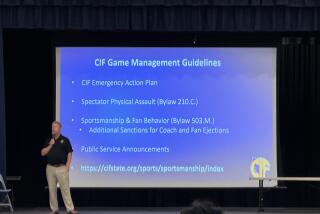A 30-day transfer rule would betray loyalty in high school sports

There’s a train wreck slowly unfolding in high school sports, and it’s time to examine the damage that might take place.
Next month, the 10 sections that make up the California Interscholastic Federation will vote on a proposal to revise transfer rules.
Under the current rules, an athlete who transfers without moving has to sit out one varsity season unless receiving a hardship waiver. It’s designed to prevent athletes from switching schools simply for sports reasons.
Now a new proposal, part of a package of changes being sold to schools, would require a 30-day sit-out period as the lone penalty for transferring.
The recruiters are doing cartwheels and want to throw a party. The schools that love transfers can’t wait to add a 30-day sit-out period to their brochures as another reason to switch schools, along with promises of more exposure and a free Nike wardrobe.
Football players would be eligible Oct. 1, basketball players Dec. 31 and baseball players April 1. Does anyone think a 30-day sit-out period is going to deter someone from transferring?
In fact, it should start a stampede of transfers this summer if approved.
Why would the commissioners around the state offer support to the proposal?
Because thousands of dollars are being spent on CIF legal bills, the hours devoted to deciding whether to grant or reject a hardship waiver keep increasing and there’s a feeling that lots of non-elite athletes are getting caught up in rules that are directed at trying to prevent schools from stockpiling athletes.
All those arguments are true, but it’s as if the commissioners are throwing up a white flag and deciding the recruiters have won.
Oh, they’re insisting they’ll be diligent and proactive when they suddenly see trends happening, such as three or four athletes transferring to a school in one sport. But they have always had the authority to stop illegal recruiting, and how many times have they acted or even hired a private investigator?
If a 30-day sit-out period is voted in, it will accelerate the trend of schools’ forming all-star teams, and that is sucking the life out of those coaches who used to believe in building programs by getting players to show up as freshmen, teaching them fundamentals and seeing them blossom as seniors. The problem is they don’t stick around for four years anymore.
Sportswriters will have to come up with a new ranking system for teams. There will be a preseason poll based on who can play immediately and another poll based on who’s eligible Oct. 1, Dec. 31 and April 1. Yes, it’s silly, but so is a 30-day sit-out period.
Coaches would face new ethics questions. If a player gets to start the first month of the season, will he or she be replaced as soon as the transfer student becomes eligible?
The decision to support or reject transfer revisions should revolve around whether the mission of high school sports will be preserved or further tarnished.
That mission has been about teaching lessons to teenagers far beyond winning championships.
Leave it up to the club programs to recruit, build all-star teams and welcome transfer students with open arms.
There has to be someone left to stand up for the kid who sticks around through the good and bad times, shows loyalty for four years, practices hard, then is sent to the bench in favor of the new kid.
On Wednesday, Southern Section schools get to vote at their council meeting whether to endorse the proposal.
It might work well in Northern California, where there’s a lack of urban areas compared with Southern California, but as a statewide proposal, it’s only going to create a new set of problems and further widen the disparity between the haves and have-nots.
twitter.com/LATSondheimer
More to Read
Go beyond the scoreboard
Get the latest on L.A.'s teams in the daily Sports Report newsletter.
You may occasionally receive promotional content from the Los Angeles Times.











